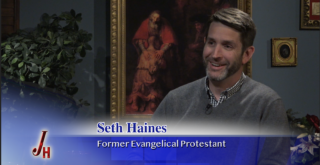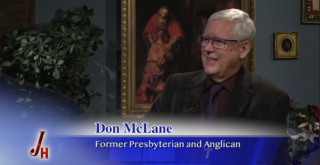
“But I believe in the Real Presence!” said Doug, my Bible Christian friend, “Why do you Catholics refuse to admit me to communion?” “Whoa!” I said, “I’m delighted to hear that you believe in the Real Presence, but what do you actually mean by this phrase?” “Well, I prefer to remain vague about the details,” said Doug. “I would only want to go as far as the Scriptures do, and St. Paul says in I Corinthians that the communion is ‘the sharing in the body of Christ.’ I don’t think you have to go further than that.”
Doug was happy to use the phrase to describe what he believed about the Lord’s Supper at his independent Bible Church. Most Anglo-Catholics use the phrase and even many Evangelical Anglicans seem fairly happy to use ‘real presence’ to describe their view of the Eucharist. Doug’s statement of belief, however, prompted in me more memories. I had come across Methodists, Reformed ministers and other free evangelicals using the phrase as well. When I became a Catholic I found lots of Catholics also using the phrase ‘real presence’ to refer to their Eucharistic beliefs.
What did everyone mean by this phrase? Could it be that God was using ‘real presence’ as a kind of ecumenical bridge? Was it becoming a universally accepted phrase which was bringing non-Catholics into the fold of the Catholic Church? I didn’t want to rule out this creative possibility, but I had my suspicions that ‘real presence’ was in fact, an elastic phrase which could mean almost anything, and was therefore the enemy of true ecumenism.
For instance, a Bible Christian might mean by ‘real presence’, “I feel closer to Jesus at the Lord’s Supper.” At the same time a Methodist might mean, “When we gather together the presence of the Lord is real among us”—referring simply to our Lord’s promise that “Where two or three are gathered together, there am I in the midst.” A Lutheran might mean Christ’s risen presence is ‘with’ or ‘beside’ the bread and wine. An Anglican evangelical might say, “There is a real sense in which Christ is present as the church gathers—for the Church too is the Body of Christ.” An Anglo-Catholic would say there is a real, objective abiding spiritual presence of Christ when the Eucharist is celebrated.
One of the reasons the phrase ‘real presence’ has become a flexible friend is because it has been lifted from its full context. Historically, Catholic theologians spoke of “the Real Presence of Christ’s body and blood in the sacrament of the altar.” More recently this has been conveniently shortened to “the Real Presence” with, at least in Catholic circles (as in the articles in this Journal), the full meaning of Transubstantiation being presumed. Some confusion has arisen as a result, since for many people ‘real presence’ has come to mean simply ‘the idea of the risen Lord’ or ‘the Spirit of Christ’ or even just the ‘fellowship of the church.’ In fact, the phrase ‘the real presence’ could mean just about anything to anybody. Undoubtedly there are modern expressions of faith that speak of the ‘real presence of the Christ within. ‘
Another reason why this phrase is so vague is because ‘real presence’ in most usage focuses on the abstract noun ‘presence’ and not on the body and blood of Christ. This implies that the ‘presence’ is somehow separate from the Sacrament.
The widespread use of this phrase is a sign that many non-Catholics are coming around to a higher view of the Sacrament. For Catholics this is—on the one hand—a cause for rejoicing. On the other hand, it is a cause for concern because many non-Catholics—upon hearing Catholics use the phrase—quite innocently assume that Catholics believe the same thing they do. Thus, a Bible Baptist might use the phrase ‘real presence’ meaning he ‘feels closer to Jesus at communion,’ and hearing Catholics use the phrase, he might conclude that Catholics believe the same thing. They do, in fact, believe what he believes—Catholics DO feel closer to Jesus at Communion—but they also believe a whole lot more.
As a result—as with my friend Doug—the Bible Baptist cannot understand why he is not welcome to receive communion at a Catholic Mass. While the widespread use of the phrase ‘real presence’ seems encouraging, in reality it’s can be misleading. This ambiguous phraseology can encourage false ecumenism when the phrase ‘real presence’ becomes an artificial lowest common denominator.
I recently did a bit of research about the origins of the phrase ‘real presence’. I wanted to find out when the phrase was first used and why. I figured that finding out the background of the phrase might explain why and how it was being used today.
The Oxford Dictionary of the Christian Church defined ‘real presence’ as an especially Anglican phrase which “emphasized the real presence of the body and blood of Christ at the Eucharist as contrasted with others that maintain that the Body and Blood are present only figuratively or symbolically.” The first edition of the dictionary quoted the sixteenth century English reformer Latimer to show his use of the phrase, “this same presence may be called most fitly a real presence, that is, a presence not feigned, but a true and faithful presence.”
That sounded pretty Catholic, but then it became a bit more complicated because the second edition of the same dictionary points out that the English Reformers only used the phrase with other expressions which made it a phrase for receptionism—the belief that the bread and wine only become the body and blood of Christ to those who receive it faithfully. Latimer is quoted in the second edition more fully, “that same presence may be called a real presence because to the faithful believer there is a real or spiritual body of Christ.”
But because Jesus said about the bread, ‘This is my body,’ Catholics believe in a corporeal, substantial presence of Christ in the Eucharist. The whole Christ is present, body, blood, soul and divinity. It is not just a spiritual presence. Furthermore Catholics believe in an objective presence—not one which is only available to those who receive in faith. This, however, is not what the Anglican reformers meant when they used the phrase ‘real presence.’
Latimer’s colleague Ridley makes the Anglican position about the real presence most clear. Writing in the Oxford Disputations of 1554 he says, “The true Church doth acknowledge a presence of Christ’s body in the Lord’s Supper to be communicated to the godly by grace…spiritually and by a sacramental signification, but not as a corporeal presence of the body of his flesh.”
This seemed to be the root of the phrase. It was a construction of the English Reformation. Latimer and Ridley did their best to come up with a phrase for the Eucharist which would please their Catholic persecutors and yet not compromise their Protestant beliefs. But maybe there was more to it. What if the phrase ‘real presence’ actually originated before the sixteenth century?
In The History of the Doctrine of the Holy Eucharist an Oxford scholar called Darwell Stone traces the Church’s beliefs about the Eucharist from New Testament times through the late nineteenth century. He shows that debates over the body and blood of Christ in the sacrament really blew up with the eleventh century French theologian Berengar of Tours. Berengar denied that there could be a material change at the consecration, and the controversy which raged for the next two hundred years ended in the definition of transubstantiation at the Fourth Lateran Council in 1215. It is interesting that during this controversy the orthodox phraseology is ‘real body and real blood of Christ.’ The phrase ‘real presence’ doesn’t occur.
I found the first reference to the phrase ‘real presence’ in the writings of the fourteenth century theologian John of Paris. He wrote, “I intend to defend the real and actual presence of the body of Christ in the Sacrament of the Altar, and that it is not there only as by way of a sign…” But John of Paris was deprived of his professorship because his specific views on the Sacrament were contrary to that defined by the Fourth Lateran Council and were therefore considered unorthodox. It was in the same century that the pre-cursor of Latimer and Ridley—John Wycliffe—also used the phrase ‘real presence’. Like Ridley and Latimer he used ‘real presence’ as an alternative to transubstantiation. In other words, ‘real presence’ was a compromise phrase used to suggest a high view of the sacrament while allowing the theologian to tiptoe around the uncomfortable doctrine of transubstantiation.
Ridley’s and Latimer’s use of the phrase ‘real presence’ stemmed from this search for a compromise phrase. They denied transubstantiation and held a merely symbolic and spiritual view of the Sacrament. In response to Catholic pressure and to avoid extreme Zwingli-ism they sought a way to express their beliefs in as high a way as possible. Thus Ridley and Latimer said they believed in the real presence; but this was simply their phrase for a kind of high receptionism.
The phrase ‘real presence’ then has—from the start—been used as an alternative to the Catholic doctrine of transubstantiation. Not only did Latimer and Ridley use ‘real presence’ to deny transubstantiation, but so did the seventeenth century ‘high church’ Anglican divine Jeremy Taylor who used the phrase ‘real presence’ as a contrast to transubstantiation in his treatise, The Real and Spiritual Presence of Christ in the Blessed Sacrament proved against the Doctrine of Transubstantiation.
The second volume of Darwell Stone shows how the great Victorian Anglican, E.B. Pusey, re-coined the phrase ‘real presence’ in the mid-nineteenth century and promoted it most strongly. It is thanks to Pusey that the phrase entered common usage within the Oxford movement and eventually made its way through the Anglican and other non-Catholic churches to be used so widely today.
But what did Pusey mean by ‘the real presence’? He was at pains to point out that he did not hold to any corporeal presence of Christ in the Eucharist. “In the communion there is a true, real actual though spiritual communication of the body and blood of Christ to the believer through the holy elements.” In another place Pusey denies transubstantiation explicitly and argues for a “mystical, sacramental and spiritual presence of the body of our Lord.” And most explicitly, in 1857 Pusey says, “there is no physical union of the body and blood of Christ with the bread and wine.”
Pusey in the Oxford of the mid-1850s was not at risk of being burned at the stake like Ridley and Latimer. But in that same university city he felt a similar pressure of trying to reconcile English reformation doctrines with the beliefs of the Catholic Church. Pusey was under pressure because he sincerely wanted the Anglican Church to be as Catholic as possible, but as an Anglican clergyman he had to subscribe to the Thirty-nine Articles of Religion, and Article 28 specifically repudiates transubstantiation. So Pusey could not hold to transubstantiation even if he wanted to.
So—like Ridley and Latimer before him—he used the phrase ‘real presence’ to sound as close to Catholicism as possible while, in fact, rejecting Catholic doctrine. Pusey believed that the ‘real presence’ of Christ in the sacrament was only a spiritual and sacramental presence. In this way the Victorian Anglo-Catholic actually agreed with the reformer Ridley who wrote, “The blood of Christ is in the chalice…but by grace and in a sacrament…This presence of Christ is wholly spiritual.”
Why does it matter whether or not we believe that the presence is only spiritual? It matters because the whole work of Christ is more than spiritual. It is physical. Ever since St. Irenaeus in the second century, the Catholic Church has been insistent that the Incarnation really is a supernatural union of the spiritual and the physical. As Darwell Stone writes, Irenaeus was countering Gnosticism, “which interposed an insuperable barrier between spiritual beings and material things, between the true God of the universe and the universe of matter.” It is one of the great heresies of our age that Christians attempt to ‘spirit away’ the physical-ness of the Gospel. So the Resurrection, the miracles and the Incarnation itself become mere ‘spiritual events.’
Likewise, the Church has always insisted—despite the difficulties—that the presence of Christ in the Blessed Sacrament is not simply spiritual and subjective. It is objective and corporeal. In some way it is physical. At the Fourth Lateran Council the Church explained this belief with the phrase “transubstantiation.” As the Oxford Dominican, Fr. Herbert McCabe has said, “Transubstantiation is not a complete explanation of the mystery, but it is the best description of what we believe happens at the consecration.”
What then, should Christians do with this confusing phrase ‘real presence’? First of all clarity and honesty are most important. Catholics should realize that when used alone, the phrase “Real Presence” is not uniquely a Catholic term. Its history is mostly Anglican, and as such it was used as a way to adroitly sidestep the doctrine of transubstantiation. Therefore, we must be careful that whenever we chose to use this phrase our hearers understand clearly the full extent of what we are inferring by it.
When our separated brethren say they believe in the ‘real presence’, Catholics should be glad that they have a fairly high view of the Eucharist, yet realize that transubstantiation is almost never meant. Like my buddy Doug, he may ‘prefer to remain a little bit vague’. And if pressed, the person will admit that by the phrase ‘real presence’ he does not mean he believes the sacrament is the body, blood, soul and divinity of our Lord. Asking the person to clarify the meaning of the phrase as they understand it could be a positive and constructive way to move a theological discussion forward.
In his 1965 encyclical Mysterium Fidei, Pope Paul VI encourages the use of clear and unambiguous language about the Eucharist. He says, “Having safeguarded the integrity of the faith it is necessary to safeguard also its proper mode of expression, lest by careless use of words we occasion the rise of false opinions regarding faith in the most sublime of mysteries.”
In the same encyclical Pope Paul actually uses the phrase ‘Real Presence’ but he does so to outline the ways in which Christ is present in his church. Interestingly, Paul VI affirms all the ways non-Catholics might define ‘the real presence.’ He says Christ is really present in the Church when she prays. He is also present when she performs acts of mercy. Christ is present in the Church as she struggles to perfection. He is really present when the Church governs the people of God. Christ is present in the preaching of the gospel and he is present as the Church faithfully celebrates the Eucharist.
However Paul VI also makes it clear that the Eucharistic presence of the body and blood of Christ is different from these other forms of Christ’s presence. It is a unique presence. So he affirms, “This presence is called ‘real’ by which it is not intended to exclude all other types of presence as if they could not be ‘real’ too, but because it is presence in the fullest sense. That is to say, it is a substantial presence by which Christ the God-Man is wholly and entirely present. It would therefore be wrong to explain this presence by taking resource to the ‘spiritual’ nature, as it is called, of the glorified Body of Christ which is present everywhere, or by reducing it to a kind of symbolism as if this most august sacrament consisted of nothing else than an efficacious sign of the spiritual presence of Christ and of his intimate union with the Faithful members of his mystical body.”
Catholics must continue to use clear language about the Sacrament. We can affirm the ‘real’ presence of Christ which non-Catholics affirm in the fellowship of the church, in the preaching of the gospel and in the celebration of the Eucharist, but we must also affirm that the fullest sense of the ‘real presence’ is that which we worship in the Blessed Sacrament of the altar.
Although Paul VI used the phrase ‘real presence’ in Mysterium Fidei the whole thrust of the encyclical is to support and recommend the continued use of the phrase ‘transubstantiation’ as the Catholic phraseology. Mysterium Fidei also encourages those devotions which are implied by the Catholic belief in the ‘real body and real blood of Christ.’ That such devotions are encouraged as a support to transubstantiation is nothing new. Just fifty years after the doctrine of transubstantiation was promulgated by the Fourth Lateran Council, Pope Urban IV decreed the Feast of Corpus Christi. The beliefs of the Church are always reflected in her devotions.
The Catholic Church encourages the devotions which accompany belief in Christ’s corporeal presence in the sacrament of the altar. It is the practice of benediction, prayer before the sacrament and veneration of the blessed sacrament which makes clear exactly what Catholics do mean by the phrase ‘real presence’ and that it is not the same thing that other Christians mean when they use the same phrase.
That many non-Catholic Christians are growing into a higher view of the Eucharist is a sign of real movement toward unity. But that true and costly re-union for which Christ himself prays will not come as long as we accept ambiguous language which allows us to pretend that we all believe the same thing. Instead unity will come as we recognize the true divisions which still exist, understand our differences and seek to resolve them with patience, love and a good sense of humor.










